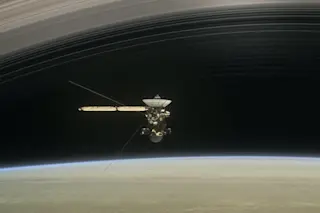Over its nearly 20 year mission, NASA’s Cassini spacecraft redefined our understanding of Saturn. And while Cassini sent its final transmissions to Earth as it dove into the ringed planet last September, scientists have just published more than half a dozen papers using data collected during its “Grand Finale.” The studies, published in both Science and the Geophysical Research Letters help refine our knowledge of the planet and its rings and how they evolved.
Planetary scientist Hunter Waite of the Southwest Research Institute and his colleagues, for instance, have uncovered how water ice rains from Saturn’s rings into its atmosphere at a whopping 22,046 lbs (10,000 kg) per second. And other materials fall from the rings, too. “Most everything we saw was unexpected,” Waite said about the material falling into Saturn’s atmosphere. “All the things besides water were not expected, so methane, carbon monoxide, molecular nitrogen,” and more were a ...














